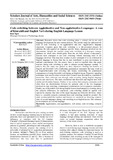| dc.description.abstract | Research shows that code switching plays a critical role in not only language development but also content delivery. The current study has addressed the issue of code switching in an agglutinative and non –agglutinative language classroom. Linguists agree that code switching is a rule-governed process. In addition, the rules applied are language specific; hence, languages involved are the determinants. Despite the teachers using code switching as a discourse strategy, guidance on which rules should guide them has not been offered. Consequently, teachers have continued to use code switching without following rules of the languages involved. This may have resulted to poor command of L2 as evidenced in English language in Kenya that has in turn contributed to poor performance in national examinations. For this reason, there is need to establish rules that guide teachers during code switching in order to enhance second language learning. To achieve this, the study was guided by three objectives: Finding out features of English and Kiswahili verb; establishing grammatical constraints that may result in an English/Kiswahili code switching and finally, establishing the grammatical consequences of using Kiswahili verb during an English lesson. Purposive sampling techniques were used to select schools where learners used Kiswahili as a medium of instruction. Data collection was through audio recording during English language lessons and interviews. The study established that Kiswahili and English have both similar and dissimilar features. Further, it was evident that syntactic constraints result when there are dissimilarities between the syntactic rules of the two languages involved in code switching. Grammatical dissimilarities led to syntactic constraints. Finally, use of Kiswahili verb during English lesson disadvantaged its learning due to the syntactic differences. In conclusion, code switching should be applied with caution by ensuring that rules of the target language are followed. However, where there is a possible syntactic constraint then code switching should be avoided. The study recommended that teachers and learners be sensitized on observing syntactic rules of second languages during code switching in an English lesson. This enhances its development as a second language. | en_US |

